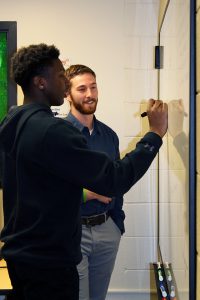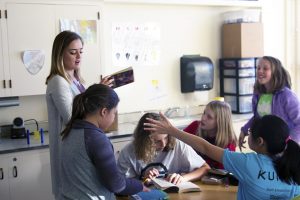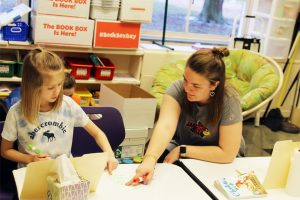By the time elementary education major Lauren Sulkowski finished her freshman year, her accomplishments rivaled those of a beginning teacher.
Her professional practice involved working with multi-tier system of supports (MTSS), formerly known as response to intervention; assessment; differentiated instruction; literacy strategies; and the creation and delivery of about 50 lesson plans. She did this work at two different grade levels, kindergarten and fifth.

Randon Recker works with a University High School student on a math lesson as part of the U-Connect program.
Now a senior, the Redbird gained the experience through a University Laboratory School program called Provide All With Success (PAWS). Established in 2012, PAWS empowers teacher candidates to conduct reading and literacy intervention for K–fifth students at Metcalf School.
A year and a half ago, a similar program was created for University High School (U-High) called U-Connect. It allows teacher candidates to provide one-on-one instruction for grades ninth–12.
“The program enables our faculty at Metcalf to serve students who have the highest need without sacrificing the personal attention for the rest of the classroom. The teacher candidates offer tier-2 support,” said Christine Paxson, the Laboratory Schools’ curriculum director.
“At U-High, the teacher candidates are actually performing an hour of the highest level of intervention twice a week during students’ free periods.”
Paxson said she modeled the programs after one she created in her previous stop as a literacy specialist. Today, there are 25 PAWS teacher candidates who help at Metcalf, serving about 250 students, and there are another 15 U-Connect workers serving U-High. The programs’ combined 38 employees (two who serve in both), span 17 different education majors.
PAWS and U-Connect are rare in that they offer candidates paid positions, and prospective members of the team are referred by current workers.
“Many of the education majors I referred to the program were hired by Ms. Paxson,” Sulkowski said. “I look for specific abilities and qualities. Their ability to conduct themselves with lesson planning and homework, how they speak to or about professors, and if they are overwhelmed with classes alone. If they are, I know that this job will be too much for them.”

Lauren Hamilton works with Metcalf School students on a literacy lesson as part of the PAWS program.
Senior elementary education major Lauren Hamilton also began her work with PAWS as a freshman. She admits she was somewhat surprised when Paxson decided to hire her just out of high school.
“At that point, my most relevant experience was babysitting,” Hamilton said. “But Ms. Paxson took a chance on me and helped me to build my skills from the ground up.”
How it works
At the beginning of the semester, PAWS workers administer a diagnostic assessment to all K-5 students. Those results allow faculty members to group together their students who need to work on the same skills (for example, short/long vowels).
Candidates use those initial student assessments to guide their lesson plans. Over the course of the semester, candidates assess their students two more times to track progress. Following those assessments, the faculty members evaluate the results and reorganize the small groups if they deem their students’ learning needs have changed.
The faculty members also continue to work with students at most risk, but they rearrange the other small groups based on each learner’s need.
Throughout the semester, candidates are also charting student notes, observations, and lesson plans in a secured Google drive accessible by Paxson and the classroom teacher.
“I monitor the candidates’ lesson plans and make suggestions,” Paxson said. “But I approach feedback with the college students the same way as I would with our faculty. I am here to support them, and I want them to be successful because they are a part of our system.”
U-High students are selected for the U-Connect based on either their freshmen entrance exams or their in class performance. This one-on-one instructional support is more fluid and can change based on the student’s most pressing needs, week-to-week. While the assessment approach mirrors what is done in PAWS, the goal is to provide strategies for the high school students to succeed in their classes.
“That’s why I focus on whatever work is most pressing for them that day, and adapt my lesson as needed. However, I am always looking for opportunities to incorporate the students’ goals,” said Emilee Baldwin, a senior middle level education major who participates in both PAWS and UConnect.
Spreading their wings
While teacher candidates are being entrusted to make a positive impact on student learning, Paxson tells the Redbirds to trust their instincts and learn from their mistakes.
“I think the one thing that makes it so valuable is you get that ability to practice being a teacher while you’re still a student,” said Randon Recker, a learning and behavior specialist major. Recker is also the head coach of the Pioneer’s freshman high school football team.
“It is definitely structured by Ms. Paxson, but she gives us freedom to try
new things.”
Sulkowski, who also started in PAWS as a freshman, describes her first day as bumpy. But she also learned a lot about her direction in the field. “I meshed so well with the older kids. I originally wanted to teach first grade, but this experience showed me that I’m most interested in fourth or fifth grade.”
Benefits all around
Paxson said the model serves everyone involved in both programs. Teacher candidates gain invaluable, real-world experience, the K–fifth grade and ninth–12th grade students grow through differentiated instruction, and faculty members use the additional feedback to bolster instruction. With PAWS, the program also allows the faculty members to provide individualized attention to students in need of the most support while still proving high-level, differentiated instruction to others in the classroom.
Teachers at U-Connect have reported that the students who have been tutored by the teacher candidates have demonstrated a 15 percent increase in test scores in the classroom. Parents are taking notice of that progress, too.
“I was in a meeting with a U-Connect student’s team, recently, and we were discussing whether she was ready to ‘fly solo,’” Paxson said. “When we got to her mother, she said, ‘I love this program, I wish she could stay in it forever!’”
Leading candidates
The teacher candidates laud Paxson as a collaborative leader and a walking encyclopedia of literacy intervention practices. “Mrs. Paxson is amazing. She is Wonder Woman,” said Baldwin. “My first semester, when I was less sure of myself, she would just take the time to show me a really awesome strategy.”
Recker added: “I would be bouncing ideas off her, and at the end of the conversation she would say, ‘Check your email when you get back. I just sent you several resources that could work.’ And whenever she could not find something right away, she would always get back to you with it.”
Before PAWS and U-Connect workers leave her program, Paxson reviews resumes and provides hiring tips pro bono.
“I can’t speak to U-Connect, because it’s too new, but not one of my PAWS workers has had any trouble finding a job immediately after graduation,” she said. “These are such quality college students and beginning teachers.”
To make the job even more collaborative, Paxson created a resource room at Metcalf where teacher candidates can access activities labeled with the most common skills taught in the small group or tutoring sessions. The resource room is also where Paxson trains new PAWS and U-Connect employees. Before she lost 18 candidates to student teaching at the end of the academic year, she hired more than a dozen reinforcements in December. The timing facilitated a semester of collaboration. But before they started working together, the 30-plus Redbirds huddled in the room on a cold Saturday before winter break.
Paxson paired the new PAWS and U-Connect workers with her existing employees, told the group what needed to happen, and let them conduct their own individual trainings.
“It was pretty awesome,” Paxson said. “One of our faculty members happened to pop in and said, ‘What a great example of a professional learning community (PLC)!’ Everyone was chatting and learning. There was just so much great ownership from our mentor workers showing the new people how to do things and teaching them the ropes.”
Paxson said the day was an absolute microcosm of what the program is supposed to be all about.
“My goal was to make this a PLC model where the college students learn to develop relationships, depend on each other, feel vulnerable, and ask for help, because that is what they are going to do as full-time teachers.”


